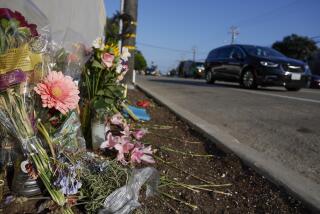Keeping Pedestrians Safe
Santa Ana has the highest death rate for pedestrians in Southern California and the third highest in the state. A Times Orange County series has pointed to several steps to lessen the problem.
For the past several months police have been cracking down on jaywalkers and on motorists who fail to yield to pedestrians. That campaign needs to continue.
But the city should take another look at the decision two years ago to raise the speed limit on one treacherous stretch of West 1st Street from 35 mph to 40 mph. That action appears mistaken. It’s time to roll back the speed.
Also needed is a more detailed city analysis of traffic accidents near schools and the absence of traffic lights in those areas. Adding crossing guards also could help.
So far this year five pedestrians have been killed by cars in Santa Ana. Last year’s pedestrian death toll in the city was five.
Police said the reasons for accidents are many. In some cases, people are jaywalking when struck. In others, motorists are going too fast. Santa Ana has a number of older, narrow streets lined with trees that can cut vision for both drivers and those on foot.
Injuries to pedestrians, especially youngsters, also are a problem.
A UC Irvine study has found that pedestrian injuries were the leading cause of severe injury in children under 14 in all of Orange County. University research found that young Latino children were at increased risk for pedestrian injuries in Santa Ana, which has a larger Latino population than any other city in the county.
The UCI researchers said most of the youngsters injured were struck not far from home, on residential streets. Those streets have 25 mph speed limits, but drivers don’t always heed them or yield to pedestrians.
As part of the city’s campaign against pedestrian injuries and fatalities, police last month began escorting home young children who jaywalked or played recklessly near busy intersections.
Police said they wanted to let the children know the need to stay on the sidewalks and the dangers from cars. Also commendable are police plans to talk with parents about the importance of teaching their children traffic safety and to follow up the talks with letters. Parents have to be the first line of education for their children. If police can reinforce the parents’ lectures, so much the better.
But it’s not just children who too often take their lives in their hands crossing Santa Ana streets. Many adults need educating as well.
That can be seen in the more than 1,500 jaywalking citations issued to pedestrians in the last few months. Jaywalking patrols and a public education campaign aimed at the city’s Latino population have been a large part of the Police Department’s effort.
An especially dangerous section has been the one mile of West 1st Street between Fairview and Bristol Streets. Since 1995, five pedestrians have been killed and six injured on the six-lane-wide stretch.
Independent traffic engineers say there might not be much the city can do to improve safety there. But reducing the speed limit from 40 to 35 would be appropriate. Installing a median also might be warranted. A stretch of West 1st Street farther east does have a median and has a better safety record.
Another area that would benefit from increased attention is the vicinity of Willard Intermediate School, on Ross Street just north of the Civic Center.
A Santa Ana Unified School District study found that in the first half of 1998, five pedestrian accidents involving children occurred within a quarter-mile of the school. That was the highest rate of any campus.
The school’s principal said her requests for crossing guards at key intersections around the school have been rejected with the explanation that the guards are provided only around elementary schools.
Intermediate school students should know better than to jaywalk, though a number do so anyway. But Times reporters who monitored the intersections around the campus last month found that most drivers rolled through stop signs and some did not slow at all.
If the stop signs don’t work, crossing guards would seem to be a necessity. So would aggressive police work. Police officials rightly say they cannot stake out every school in the district. But extra attention to problem areas can pay benefits and offer extra protection for Santa Ana’s children.
More to Read
Sign up for Essential California
The most important California stories and recommendations in your inbox every morning.
You may occasionally receive promotional content from the Los Angeles Times.









